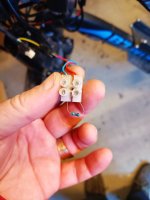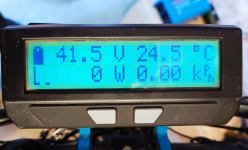HolgiB
10 W
- Joined
- Oct 2, 2018
- Messages
- 70
Hey there,
I have been searching ES for a while but not really found an answer. So there you go
I have a Grinfineon 4825 controller paired with a Cycle Analyst V3. Now I bought a fast Nine Continent RH 212 from a German vendor.
This is identical to the motor which is sold by Grin: FH212 Fast Wind
I will switch out my existing cheap DD hub motor to the RH212 this weekend and I have a temperature sensor now. So the question that arises to me:
Which temperature borders do I chose for thermal throttling with my Cycle Analyst ?
I asked over at the German Pedelecforum but didn't receive any answer. One guy over at the forum did use 90°C as starting point and 120°C as upper thermal limit.
Any ideas ? Otherwise I will start conservative with 90°C lower and 110°C upper limit.
TIA,
Holgi
I have been searching ES for a while but not really found an answer. So there you go
I have a Grinfineon 4825 controller paired with a Cycle Analyst V3. Now I bought a fast Nine Continent RH 212 from a German vendor.
This is identical to the motor which is sold by Grin: FH212 Fast Wind
I will switch out my existing cheap DD hub motor to the RH212 this weekend and I have a temperature sensor now. So the question that arises to me:
Which temperature borders do I chose for thermal throttling with my Cycle Analyst ?
I asked over at the German Pedelecforum but didn't receive any answer. One guy over at the forum did use 90°C as starting point and 120°C as upper thermal limit.
Any ideas ? Otherwise I will start conservative with 90°C lower and 110°C upper limit.
TIA,
Holgi





